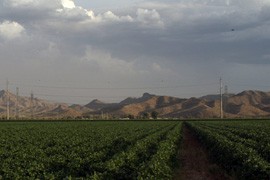- Slug: BC-CNS-Cotton Boom, 1st Ld-Writethru,725
- Note: CORRECTS to Lavis sted Labis in
- Sidebar: Key facts about cotton demand, prices.
- Photos available (thumbnails, captions below)
- Multimedia: YouTube video
By JENNIFER A. JOHNSON
Cronkite News Service
GOODYEAR – Ronald Rayner has weathered many ups and downs in the four-plus decades he’s grown cotton in the West Valley.
For Rayner, and for many other cotton farmers in the state, it’s looking like an up year.
Purchases of everything from bath towels to jeans have boosted demand for the fiber and improved prospects for growers in Arizona and around the world.
U.S. farmers have booked sales of 6.25 million bales of cotton this year, more than twice as much as the previous year, according to U.S. Department of Agriculture data as of Aug. 19. A cotton bale weighs 480 pounds.
Globally, production will fail to keep pace with demand for the fifth-straight year, according to the USDA.
“It’s hard to see that we could supply more than what the market would need the next few years,” said Rayner, who runs the sprawling A Tumbling T Ranches in Goodyear with two brothers and two nephews. “That should bode well for cotton farmers in the state.”
Rayner said he may plant more cotton next year if demand remains strong.
This year Rayner planted 1,000 acres, up from only 200 acres two years earlier. Growers in Arizona planted 188,000 acres of cotton this year, up 28 percent from a year earlier, according to USDA data published in August.
Cotton in Arizona, which is mostly the upland variety but includes a small amount of higher-quality Pima cotton, is grown primarily along the Interstate 10 corridor from Tucson to Phoenix. The majority of the harvest begins in October.
“During the recession, we could hardly give cotton away,” said Jesse Curlee, president of Phoenix-based Supima, an industry group that represents Pima cotton growers. “We are seeing huge demand and big premiums so farmers want to grow cotton again.”
Cotton farmers typically lock in prices on the futures market, sometimes before cotton is harvested. The real challenge for farmers in the state is deciding when to lock in prices, said Trent Teegerstrom, an associate extension specialist with the University of Arizona Department of Agriculture, Resources and Economics.
Cotton prices on IntercontinentalExchange Futures U.S. in New York have more than doubled since the textile industry’s collapse during the recession, when cotton plunged to 39.23 cents a pound in November 2008. On Monday, cotton traded at 86.43 cents a pound, driven by demand in emerging markets like China and India and the tightest global inventories in more than a decade.
“Anytime you can get a price over 70 cents a pound, you are in nirvana,” said Rick Lavis, executive vice president of the Arizona Cotton Growers Association, a trade group that represents the state’s 900 growers. “It’s been a positive year for cotton growers in the state.”
Farms, cotton gins, merchants, warehouses and mills in Arizona bring an estimated $258 million each year to the state’s economy, according to National Cotton Council of America data. For the first time in five years, U.S. exports are expected to expand, jumping by as much as 25 percent, according to the USDA.
Cotton prices also gained this year as floods and landslides in China, the world’s largest grower, and Pakistan, the fourth-largest grower, curbed cotton output. India also halted exports in April to cool prices and provide relief to mills. The country announced last week it will ease restrictions on exports beginning Oct. 1.
Arizona’s cotton acreage declined in recent years as land was sold for development, cotton prices collapsed and farmers chose to plant more lucrative crops like alfalfa, according to Lavis.
“Farms make choices based on the factors in front of them, and in the last few years we just weren’t growing as much cotton,” he said. “It’s a function of price and demand.”
Rayner, who also grows alfalfa, sorghum silage and Durham wheat, said cotton accounts for the smallest portion of the farm’s total profits. He planted more cotton this year because demand for alfalfa waned as the recession-battered dairy industry reduced herds.
“Cotton has always been one of the state’s staple crops, but it’s been on the decline,” the UA’s Teegerstrom said. “For sure you’ll see an uptick in planting next year.”
U.S. farmers will harvest 18.53 million bales this year, up 52 percent from a year earlier, USDA data shows. The global harvest is expected to jump 14 percent to 116.85 million bales, the most in three years, the department said.
“Many farmers have looked into expanding,” Rayner said. “While direct employment may be small, the multiplier effect that cotton sends through rural communities in the state is unbelievable.”
^___=
Web Links:
_ U.S. Department of Agriculture: www.usda.gov
_ UA Cooperative Extension: extension.arizona.edu
^___=
Key facts about cotton, prices and demand
By Cronkite News Service
Here are some key facts about cotton and this year’s demand:
– Arizona farmers have planted 188,000 acres of cotton this year, almost all of it the upland variety.
– Cotton prices of more than 80 cents per pound are more than double prices in 2008.
– U.S. farmers have booked sales of 6.25 million bales of cotton this year, more than twice as much as the previous year.
– Global production in 2010 will fail to keep pace with demand for the fifth-straight year, according to the U.S. Department of Agriculture.
^___=

Ronald Rayner, shown at Tumbling T Ranches in Goodyear, says high demand makes this a good season for Arizona’s cotton farmers. Industry leaders say global production of everything from jeans to bath towels is fueling the boom.
(Cronkite News Service Photo by Jennifer A. Johnson)

Cotton blooms at Tumbling T. Ranches in Goodyear. Global demand is creating higher prices this season, creating good times for Arizona cotton growers. (Cronkite News Service Photo by Jennifer A. Johnson)
Cotton grows at Tumbling T. Ranches in Goodyear. Global demand is creating higher prices this season, creating good times for Arizona cotton growers. (Cronkite News Service Photo by Jennifer A. Johnson)
